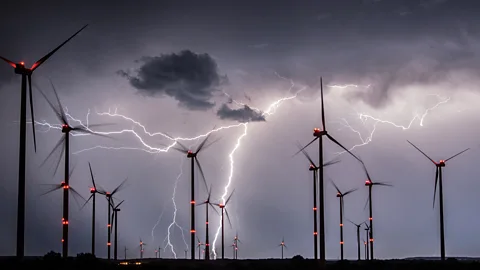How harvesting electricity from humid air could one day power our devices
 Getty Images
Getty ImagesFamed physicist Nikola Tesla wanted to obtain electricity from humidity in the air, harnessing the processes that take place in storm clouds: decades after his death, the idea could finally be coming to fruition.
No-one in the lab could quite believe what they were seeing. An experimental device, a humidity sensor, had started generating electrical signals. Fine, you might think – except that shouldn't have been possible.
"For some reason, the student who was working on the device forgot to plug in the power," says Jun Yao at the University of Massachusetts Amherst. "That's the start of the story."
Since that moment five years ago, Yao and his colleagues have been developing a technology that can harvest electricity from nothing but humid air: a concept known as hygroelectricity.
It's an idea that has been around for many years. Nikola Tesla and others have investigated it in the past but never achieved promising results. However, that could be about to change.
Multiple research groups around the world are discovering new ways of gleaning electricity from water molecules that naturally float in the air. It is possible because those water molecules can transfer tiny electrical charges between themselves – a process that researchers are aiming to control. The challenge is picking up enough electricity to be usable. But scientists now believe they may be able to harvest enough to power miniature computers or sensors.
It raises the tantalising prospect of a new form of renewable energy that might be floating all around us, practically 24/7.
 Alamy
AlamyIn 2020, Yao and his colleagues published a scientific paper that described how tiny protein nanowires, produced by a bacterium, could harvest electricity from the air. The exact mechanism is still under discussion, but the material's tiny pores appeared to be able to trap floating water molecules. As they rub against the material, the water molecules also appear to lend it a charge.
Yao explains that, in such a system, most molecules stay near the surface and deposit lots of electrical charge while a few others penetrate more deeply. This creates a difference in charge between the upper and lower parts of the material layer.
"Over time, you see that there is charge separation happening," says Yao. "That's actually what happens in a cloud." On a much larger and more dramatic scale, storm clouds also create a build-up of opposing electrical charges that eventually discharge in the form of lightning.
This means that, by influencing the movement of water molecules and creating just the right conditions for charge separation, you can generate electricity. "The device can work literally anywhere on Earth," says Yao.
That 2020 paper turned out to be the tip of the iceberg.
Yao and his colleagues published a follow-up study in May 2023 where they created the same kind of structure, filled with nanopores, but using a variety of different materials – from graphene oxide flakes and polymers to cellulose nanofibers derived from wood. They all worked, albeit with some small differences. This suggests the structure is what matters, rather than the material itself.
In the experiments so far, devices thinner than a human hair generated very small amounts of electricity, equivalent to a fraction of a volt. Yao suggests that by simply making more material, or linking pieces of it together, you could begin to get useful charges of multiple volts and up. It could even be made from a liquid that could be sprayed onto surfaces to provide an instant power source, he suggests.
"I think it's really exciting," says Reshma Rao, a materials engineer at Imperial College London in the UK, who was not involved in the study. "There's huge flexibility in the kind of materials you can use."
Nevertheless, it might not be realistic to imagine such technology powering entire buildings or energy-hungry machines like cars, Rao cautions. Humidity might only be enough to power internet-of things-devices, such as sensors, or small wearable electronics.
Yao's is far from the only team investigating humid air as a potential energy resource. In 2020, a group in Israel managed to harvest electricity by passing humid air between two pieces of metal. The moist air induced a charge in the metal as it flowed over it.
This phenomenon was first recorded in 1840, when a train driver at a coal mine north of Newcastle, in northeast England, felt a strange tingling feeling in his hand while operating the engine. Later, he noticed a tiny spark jumping between his finger and one of the vehicle's levers. Scientists who investigated the incident concluded that steam rubbing against the metal of the engine's boiler had caused a charge to accumulate.
Colin Price, a researcher in atmospheric sciences at Tel Aviv University in Israel, who co-authored the 2020 paper, says the charges generated in lab experiments using small pieces of metal were very low. However, he adds that he and colleagues are working on improving their system. Still, one limitation could be that they required a relative humidity of 60% or higher, whereas Yao and his colleagues' devices begin generating electricity at a relative humidity of around 20%.
Meanwhile, a team in Portugal is working on a European Union-funded project called CATCHER, which also aims to harness humid air as a source of energy. Svitlana Lyubchyk, a material's scientist at Lusófona University in Lisbon, Portugal, is coordinating the project, and has co-founded a company called CascataChuva.
"I think the engineering prototype will be ready by the end of this year, more or less," says Lyubchyk, while her son Andriy Lyubchyk, who is also a co-founder of the company, presents a video of a small LED light being turned on and off. He holds up a grey disc about 4cm (1.6in) in diameter, made of zirconium oxide, explaining that this material can trap water molecules from humid air and force them to flow through tiny channels. He says this generates an electrical charge, enough to supply about 1.5 volts from a single disc. Just two discs are enough to power the LED, he claims, adding that many more pieces of the material could be chained together to create an even bigger output.
 Getty Images
Getty ImagesHowever, while some information about the work is available online, full details regarding the team's latest experiments are yet to be published or peer-reviewed. The group also declined to share any materials showing how the discs are connected to the LED to power it.
You might also like:
Many questions remain over the mechanisms behind all of these hygroelectrical endeavours, says Rao. "There's a lot more to be investigated in terms of the fundamentals of why this works."
There's also the matter of commercialisation. Anyone seeking to commercialise technology like this will need to prove sufficient power output and cost-competitiveness compared to other renewables, says Sarah Jordaan, a civil engineer at at McGill University in Canada, who studies the environmental and economic trade-offs of energy decisions.
More established renewable energy technologies such as wind and solar clearly have a head start. They will probably prove far more significant in the coming decade, a time when transitioning away from fossil fuels is particularly urgent.
Despite these challenges, Rao says there remains a "ray of hope" that new energy materials will emerge from research into hygroelectricity.
--
